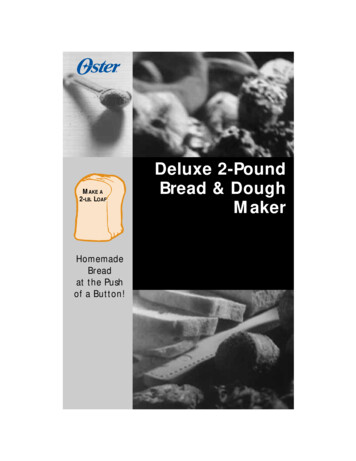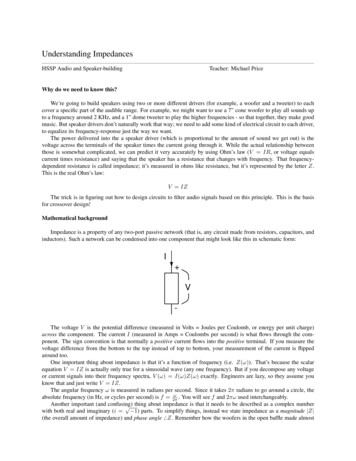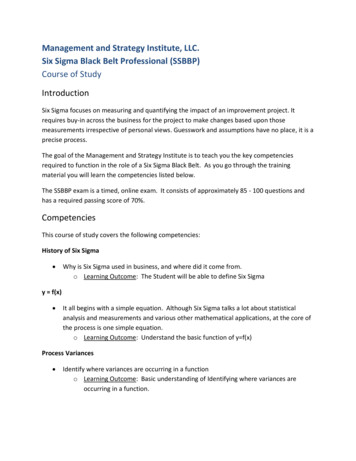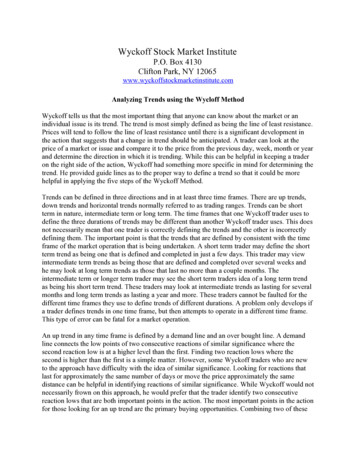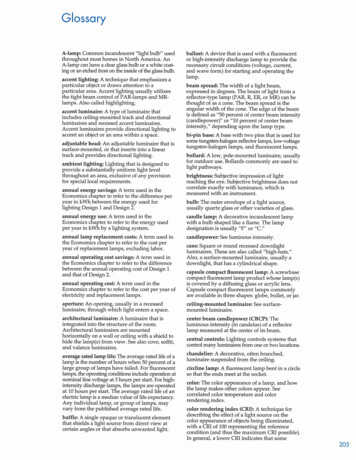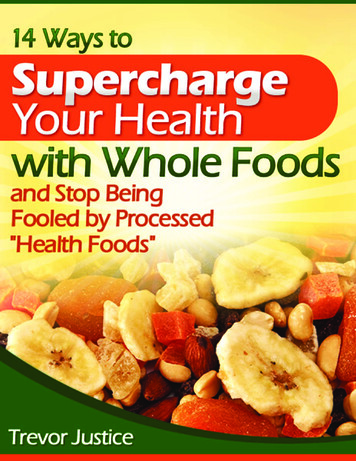
Transcription
14 Ways ToSupercharge Your Health with Whole FoodsAnd Stop Being Fooled by Processed “Health Foods”Copyright by Trevor Justice 2011If you’re like many health conscious people, youprobably eat whole wheat bread, whole grainpasta, organic corn chips, fruit juice, and saladdressings made from olive oil or flax oil.And if you’re a vegan, chances are good you eatEarth Balance, Daiya vegan cheese, and CoconutBliss. But guess what?These “health foods” aren’t optimal for your health.Why not?They’re made from fractured and processed foods.When food is ground, powdered, processed, andoxidized, it loses nutrition. And we’ll prove it belowwith data from the USDA National Nutrient Databasefor Standard Reference - Release 23. For brevity, we’recalling it USDA SR23.That’s one reason we created the Vegetarian MasteryProgram, Vegan Mastery Program, and High RawMastery Program. In these groundbreaking onlinecourses, you learn to thrive on whole food meals andsnacks, and not be vulnerable to deficiencies. We alsooffer two free books: a vegetarian nutrition guide andvegan nutrition guide.To receive gluten-and-dairy-free menu plans,grocery lists, and delicious recipes, click here.To cleanse and rejuvenate yourself with raw foods,click here. To lose weight forever eating deliciouswhole foods, click here. To take our quiz and get yourhealthy eating score, click here. Or to get our freebook “The Secret To Being Fit Forever”, click here.Not only are processed foods less nutritious. Mostof them contain additives that would make your greatgrandmother roll over in her grave!If you have visitors, fans, or email subscribersinterested in vegan health, and you’d like to get paidfor giving away this book, click here. Even if youdon’t have fans or subscribers, feel free to forwardthis book to others. You have our permission!Here’s the truth. Our bodies are designed to absorbvitamins, minerals, and other nutrients from wholefoods in their original form the way they came fromnature. Yet food manufacturers have convinced usthat fractured and processed foods are “health foods”.As we look at the 14 food categories below, you’llsee why many so-called “health foods” are secondrate compared to whole foods. Where not specified,our nutrition data comes from manufacturer nutritionlabels and the USDA SR23.BREADMost processed:Less processed:Optimal:white breadwhole wheat breadsprouted whole grain breadThe germ of a whole grain contains live protein, vitaminsE, B-complex, and essential fats. The kernel is designedto protect the germ, because most B Vitamins and fats aresensitive to light, heat, and air. But once the kernel is pulverizedinto flour, the germ is exposed and unprotected.1What’s more, grinding grains into flour increases the surface area.What’s wrong with that?When you eat grains in their original whole form, the starch isdigested slowly. But the starch in flour turns into glucose much faster. That’s why whole wheat breadhas the same high Glycemic Index (GI) rating as white bread, about 70 2. In other words, they both causeblood sugar spikes.2
The Glycemic Index is achart that ranks foods on ascale of 1-100, showing howmuch glucose is releasedby a particular food over a2 to 3-hour period in yourbloodstream.A GI rating of 70 isconsidered high. Eating lotsof high GI foods – like whitebread and whole wheatbread – produces blood sugarspikes that can lead to insulinresistance. In turn, insulinresistance can lead to obesity,high blood pressure, elevatedblood fats, and an increased riskof type 2 diabetes.11 slice whole-wheat bread 69.2 CaloriesCalories: 69.2 kcal, 3%Carbs: 11.6g, 4%Fat: 0.9g, 1%Protein: 3.6g, 7%1 slice Manna Organics multigrain breadDescription69.2 CaloriesCalories: 130 kcal, 6%Carbs: 26g, 9%Fat: 0.0g, 0%Protein: 6g, 12%1 slice wholewheat breadVitamin AVitamin CCalciumIronSodium1 slice Manna Organicsmultigrain bread000%0%000%0%30 mg0.7 mg132.2 mg3%4%6%20 mg1.8 mg10 mg2%10%1%Percent Daily Values are based on a 2,000 calorie diet and this FDA web site. Your daily values may be different, but you can still use the %DV as a frame of reference.In Lesson 33 of The MasteryProgram, “The Glycemic IndexDemystified”, you’ll discover: DescriptionWhich carbs cause blood sugar spikesWhich carbs put you at the greatest risk fordiabetes, heart disease, and breast cancer.Three ingredients you can combine withthese carbs to slow down the rise in yourblood sugar.How cooking, mashing, ripeness, and fibercontent all affect a food’s G.I. score, and itsimpact on your blood sugar levels.You’ll also get a downloadable 1-hour Q&A ofGinny Messina, RD, answering student questions.Ginny is the author of several books, includingThe Vegetarian Way: Total Health For You and YourFamily.For the moment, just know that keeping grainsin their original whole form slows the digestion ofstarch and prevents blood sugar spikes.1That’s why we recommend whole grain bread,the kind where you actually see pieces of wheat,oats, rye, or other grains on the cut surface of eachslice.In Lesson 22 of The Mastery Program – “How ToReplace Flour With Whole Sprouted Grains” –you’ll discover how to: Sprout grains without the risk of moldMake “dough” from sprouted whole grainsinstead of flourMake homemade breads, crackers, andcookies from sprouted whole grainsPreserve the nutrition in sprouted wholegrains with low temperature bakingWhy some gluten-intolerant people can eatsprouted whole grains with no problemsYou’ll also get a downloadable 1-hour Q&A ofSteve Meyerowitz, “The Sproutman”, answeringstudent questions. Steve is the author of severalbooks, including Sprouts: The Miracle Food.For now, look for Manna Organics or Ezekielbread in the refrigerated section of your health foodstore. Both of these are made with sprouted wholegrains instead of flour. Both have more protein andiron than whole wheat bread, but less fat and lesssodium. Manna bread is also yeast-free. That meansit doesn’t fluff up or “rise”, so it’s unusually dense.3
SWEETENERSMost processed:Less processed:Optimal:white or brown sugar, pancake syrup, evaporated cane juicemaple syrup, brown rice syrup, coconut nectardates, fruit, raw honey, homegrown steviaMaple syrup, brown rice syrup, and coconut nectar aremiles ahead of ultra-refined sugars, that’s true. Butthey’re still processed foods.By contrast, dates and other fruits are whole foods, rich infiber, vitamins and minerals. You can chop dates into your cerealor oatmeal. Or you can puree them into anything you make in ablender or food processor.Except for Vitamin B2 and manganese, maple syrup pales incomparison to dates, the real nutrient powerhouse in this category.Cherie Soria – one of the guest experts you’llmeet in The Mastery Program – finds that themild flavor of dates is easily camouflaged byother ingredients. She uses soaked, blended datesto thicken raw puddings, pie fillings, and sauces.When she needs a binding agent for raw piecrusts, cakes, or cookies, she blends unsoakeddates with nuts and/or dried coconut — usinga food processor. Dr. Ritamarie Loscalzo createda Date Paste recipe to replace traditional syrups.See below.So if you’re a diabetic – or if blood sugar spikesare your main concern – consider homegrownstevia. Or check out green stevia at your healthfood store. (It’s less processed than white stevia).Stevia has a G.I. rating of zero.10 And unlikedates, it easily dissolves into lemonade or tea.If avoiding blood spikes is more importantto you than eating whole food sweeteners,you’ll love Lesson 34 of The Mastery Program– “Natural Sweetener Showdown”. In it you’lldiscover:What about other unprocessed sweeteners?Raw honey is unprocessed, but it isn’t foreveryone. It’s not vegan. And it’s not good fordiabetics, since it has a GI of 35-58.10 Pros and cons of 19 different sweeteners Pros and cons of lesser-known sweetenerslike Xylitol, stevia, and coconut palmsugarThen again, dates aren’t a great choice fordiabetics either. Their G.I ranges from 31-62.10 Which sweeteners are questionable ordangerousDate Paste(by Dr. Ritamarie Loscalzo)From Dr. Ritamarie’s book, Dessert: Making It Rich Without Oil1/2 pounds pitted dates1) Soak pitted dates in 1 cup room temperature or warm water for30 minutes.2) Blend dates together with the soak water until smooth.3) Store in refrigerator.4
Glycemic index ratingsfor all sweeteners How to turn driedfruits into syrups andpastes Which fruits bestcomplement chocolatedesserts vs. cookies vs.graham cracker crusts.You’ll also get adownloadable 1-hour Q&A ofDr. Ritamarie Loscalzoanswering student questions.Then in Lesson 37 –“Secrets To Cooking WithHealthy Sweeteners” – you’lldiscover: How to substitutefruits for liquidsweeteners like maplesyrup. How much healthysweetener or fruitshould you use toreplace sugar (what’sthe ratio)?1 Tbsp maple syrupDescription52 CaloriesCalories: 52 kcal, 3%Carbs: 13.4g, 5%Fat: 0.0g, 0%Protein: 0g, 0%1 medjool dateDescription66.5 CaloriesCalories: 66.5 kcal, 3%Carbs: 18g, 4%Fat: 0.0g, 0%Protein 0.4g, 1%1 Tbsp maple syrupB1B12B2B3B5B6FolateVitamin AVitamin CVitamin DVitamin EVitamin K0.0 mg0.0 µg0.3 mg0.0 mg0.0 mg0.0 mg0.0 µg0.0 IU0.0 mg0.0 IU0.0 mg0.0 µg0%0%18%0%0%0%0%0%0%0%0%0%1 medjool date0.2 mg0.0 µg0.1 mg4.5 mg0.8 mg0.2 mg28.0 µg0.0 IU0.0 mg0.0 IU0.9 mg8.3 µg1 Tbsp maple syrupCalcium20.4 mgCopper0.0 mgIron0.0 mgMagnesium4.2 mgManganese0.6 mgPhosphorous 0.4 mgPotassium42.4 mgSelenium0.1 µgSodium2.4 mgZinc0.3 mg2%0%0%1%30%0%1%0%0%2% How do you adjust arecipe when replacingsugar with a liquidsweetener – so thefinal product isn’t toorunny? How do adjust thebaking time? How do you offset thechange in texture? Which flavors and recipes are complimented by bananas vs. other fruits?13%0%6%23%8%10%7%0%0%0%6%10%1 medjool date50.0 mg0.4 mg3.1 mg99.0 mg2.2 mg295 mg297 mg14.7 µg186.0 mg2.2 mg5%20%17%25%110%30%8%21%8%15%Percent Daily Values are based on a 2,000 calorie diet and this FDA web site. Your daily values may be different, but you can still use the %DV as a frame of reference.You’ll also get a downloadable 1-hour Q&A of Elaina Love answering student questions. Elaina is aChef/Instructor at the renowned Living Light Culinary Arts Institute, and the author of Elaina’s Pure JoyKitchen.5
PASTAMost processed:Less processed:Optimal:pastawhole grain pasta, brown rice noodles, kelp noodlesspaghetti squash, zucchini “pasta”Of course whole wheat pasta and brown rice noodles are better thanwhite pasta. But for the reasons we outlined above (under “Breads”),flour products play second fiddle to their whole grain counterparts.Kelp noodles are in the middle category because they’re a processed foodmade with Sodium Alginate.Spaghetti squash, on the other hand, is a whole food. So is zucchini. Andfans of raw food have come up with a great way to enjoy zucchini “pasta”.Jut push a zucchini through a Saladacco Spiral Slicer and it looks like thephoto above.CRACKERSMost processed:Less processed:Optimal:crackerswhole wheat crackersflax crackersWhole wheat crackers are a step in the rightdirection. But for the reasons stated above,flour of any kind is a far cry from its wholegrain counterpart. That’s why we suggest makingcrackers from flax seeds.Photo by Matt AlvordFlax seeds are higher in protein and lower in sodiumthan a Tablespoon of low salt whole wheat crackers.Flax crackers are also higher in fat. However, theycontain healthy Omega 3 fatty acids, while crackerscontain isolated oils with less favorable Omega 6:3ratios. And that bring us to the topic of Omega 3s.Most people know that flax seeds – along withhemp seeds, chia seeds, and walnuts – are greatsources of Omega 3 fatty acids. What few peoplerealize is that they only contain a short chainfatty acid called ALA (alpha-linolenic acid).6in vegans and vegetarians than in meat-eaters. 3 4Can your body convert ALA to EPA and DHA?It’s possible. However — and this is a BIG“however” — the rate of conversion is low inwomen and very low in men.6 Why?Your body also needs two long chain Omega-3fatty acids: EPA (eicosapentaenoic acid) and DHA(docosahexaenoic acid).The modern American diet is loaded with oilsthat are high in Omega 6 fatty acids.Unfortunately, EPA and DHA are almost nonexistent in plant foods. No wonder studies havefound that blood levels of EPA and DHA are lowerThe optimal ratio of Omega 6 to Omega 3is about 1:1 (an equal amount of both).7Unfortunately, many oils have terrible ratios. For
example, corn oil has a 57:1 ratio and saffloweroil has a 76:1 ratio (in favor of Omega 6)!If you eat processed foods, packaged foods, orrestaurant foods made with the wrong oils, thisOmega 6:3 imbalance can interfere with DHAand EPA production in your body even if youeat plenty of flax seeds and walnuts.9In lesson 5 of the Mastery Program -- “How toConvert ALA (the Plant-Based Omega 3) intoEPA and DHA” – you’ll discover: Which foods and oils interfere with yourbody’s ability to make DHA and EPA. How to maximize DHA and EPAproduction. The latest RDA for men, women, children,and pregnant and breastfeeding mothers A chart showing the Omega 6:3 ratios of18 different oils.You’ll also get a downloadable 1-hour Q&Aof Michael Klaper, M.D, answering studentquestions.Would you like menu plans, grocery lists, anddelicious recipes that include chia seeds, flax oil,and vegetables with excellent Omega 6:3 ratios and exclude fats and oils with poor Omega 6:3ratios? Click here for gluten-and-dairy-free wholefood menu plans that meet these criteria. Or clickhere for raw food menu plans that meet the samecriteria.Flax Crackers(by Rose Lee Calabro) 4 C whole flax seeds,soaked 4-6 hours in 3 cupswater 1/3 – 1/2 cup Nama Shoyu Juice of 2-3 lemonsPour 4 cups of flax seeds ina bowl with 3 cups of water.After four hours, add the Nama Shoyu and lemonjuice. Spread the mixture as thin as possible(about ¼” thick) on dehydrator trays with teflexCHIPSOMost processed:Less processed:Optimal:rganic corn chips arecertainly better thanDoritos. But whenit comes to vitamins andminerals, corn do
Chef/Instructor at the renowned Living Light Culinary Arts Institute, and the author of Elaina’s Pure Joy Kitchen. Calcium 20.4 mg 2% 50.0 mg 5% Copper 0.0 mg 0% 0.4 mg 20% Iron 0.0 mg 0% 3.1 mg 17% Magnesium 4.2 mg 1% 99.0 mg 25% Manganese 0.6 mg 30% 2.2 mg 110% Phosphorous 0.4 mg 0% 295 mg 30% Potassium 42.4 mg 1% 297 mg 8%
